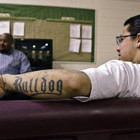
Former Georgia DJJ Officer Arrested for Alleged Sexual Assault of 14-Year-Old in Custody
|
A former Georgia Department of Juvenile Justice (DJJ) corrections officer was arrested Wednesday for alleged sex crimes that occurred while she was a staff member at the Regional Youth Detention Center (RYDC) in Gainesville. Ardith Brown faces charges of felony child molestation and sexual assault against persons in custody. Brown was removed from duty at the RYDC and suspended in January after other corrections officers alerted a DJJ Safety and Security Team to evidence of officer misconduct during an unannounced inspection. She was terminated February 2 following a DJJ internal investigation into allegations Brown had an inappropriate relationship with a 14-year-old RYDC resident in DJJ custody. The Gainesville RYDC was the first DJJ secure facility to receive a surprise facility inspection after Commissioner L. Gale Buckner began a system-wide security sweep crackdown following a homicide at the Augusta YDC campus last November.








